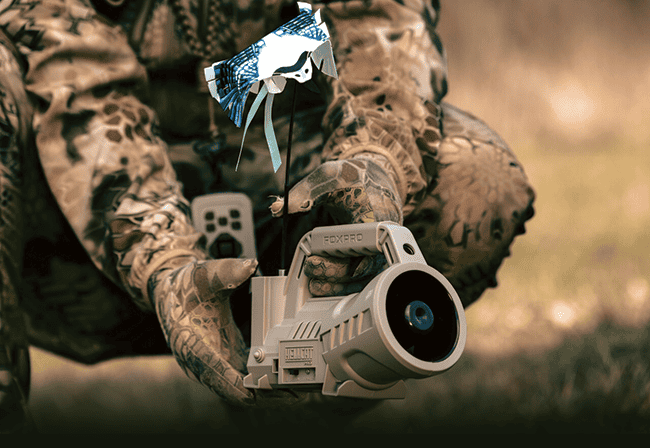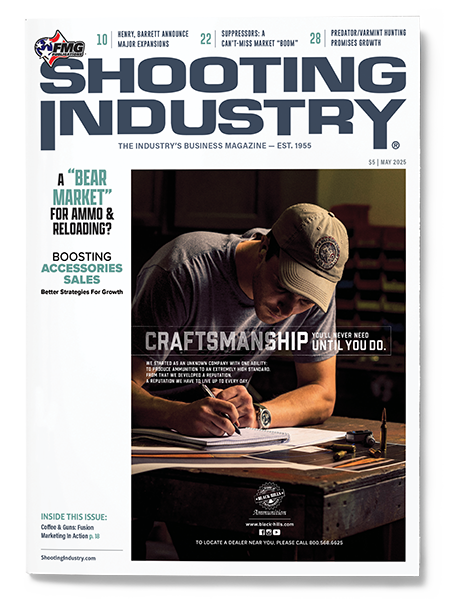Hunting The Hunters
Conservation Concerns Fuel Predator & Varmint Sales
A few years ago, the Department of Natural Resources [DNR] said they put a camera on a coyote den, and that one den had 44 fawns in it.” This astounding statement came from Mark Abel with HOP Armament/HOP Munitions in Ashland, Ohio, as we were discussing how varmints and predators affect wildlife management.
Predators. Varmints. None of us want them killing or harassing our livestock and our pets, and we also don’t want them destroying the wildlife population. Thankfully, there is a variety of excellent equipment available to help, and retailers should think about tailoring some of their marketing to focus on the need for conservation.
Varmint Trends
Abel continued to discuss the concerns in his area. As for varmints, he said raccoon hunting has lost popularity because the fur market value has declined, but hunters still recognize the importance of keeping this population under control. Groundhog hunters are a large sector of the market as well.
However, one threat of big concern a lot of people don’t think about is opossums.
“One of the most detrimental animals for the ecosystem is opossums. People like that opossums eat ticks, but they don’t realize they destroy turkey nests and eat the eggs,” he said.
When asked which firearms are popular for hunting predators and varmints, and if there are any new and upcoming changes, Abel noted, “The standard varmint guns for groundhogs around here are the classic .22 LR and the .17 HMR. But there are a lot of new calibers coming that are interesting to see like the .22 Creedmoor and the .22 TCM.”
Abel says for coyotes, hunters are using the 6.5 Creedmoor, .300 Blackout, 5.56 or .22-250.
Predator Hunter Staples
Kelley Powers, founding owner of Final Flight Outfitters in Union City, Tenn., confirmed coyotes are the biggest problem in their area as well.
“Coyotes can do a lot of damage, especially to turkey nests. Habitat management and conservation is a big push right now,” he shared.
Powers said hunting for predators is a year-round activity for the most part, but from a sales standpoint the peak for them is January and February (which is coyote mating season).
For gear, Powers says they carry many different rifles and makes, and different platforms to choose from.
“Obviously your smaller caliber rifles are popular, such as .223/5.56 and .22-250. Those are the staples from a gear standpoint,” he noted.
Customers are also interested in new tripods, bipods and an adequate shooting rest.
When asked what he’d advise a new predator or varmint hunter, Powers stated, “The first thing I would do is make sure they have an adequate firearm. A lot of it depends on the terrain they’re hunting or if they are hunting open fields.”
When shooting in close quarters, he recommends a shotgun as it’s highly effective in that area.
“From there, we go through the setup to make sure it’s comfortable,” he said. “We also recommend a good call. We try to keep it budget-conscious because some of these calls can be quite expensive as well. The electronic FOXPRO is a staple. They’re very popular and we offer multiple different styles of FOXPROS as well as e-callers.”
Powers pointed out that because deer hunting is such a huge sport in their area, they talk with the customer to find out if a rifle or shotgun they already have in their gun safe will work for hunting the predators or varmints they are concerned about.
Connecting With Hunters
As far as marketing to the predator/varmint hunter, Abel noted while HOP Armament/HOP Munitions initially focused on the tactical market, they’ve since learned just how incredibly vast the hunting market is.
He elaborated, “For instance, we were contacted by the USDA out of Texas to develop a 62-grain non-lead 5.56 round specifically for culling hogs. So, we developed a 62-grain round called a REX Round and it’s all copper. They were very happy with that, and they ordered a lot of rounds.”
I asked Abel what he would say to retailers to encourage them to focus on the wildlife management aspect for sales.
“My word of encouragement to retailers would be that the predator world is growing; we’re worried about about hogs coming up, and we’re worried about bobcats coming in. There are species I’ve never heard of, but my buddies in the DNR talk about them,” he said. “So, I would encourage retailers to give their customers some good options not only with the ammo and the rifles but with the accessories like thermals and suppressors as well.”
Suppressors On The Rise
When asked what advice he would give to someone new to predator or varmint hunting, Abel identified a burgeoning subcategory.
“I always try to find out what the customer wants so I’m not selling them what I prefer, but what best fits their wants and needs,” he said. “But if it’s just for predator hunting, I’m old school. I don’t particularly care for the ARs for hunting. It’s just a personal thing. There are a lot of good hunters who carry ARs in the woods and I have no problem with that. They have their reasons.
“Semiautomatic rifles allow for quick follow-up shots, and the 5.56 gives them the option of .223/5.56 out of the same rifle and they can put a suppressor on it. It won’t be ‘Hollywood quiet’ but it will be quieter.”
He recommends the Ruger American because it can utilize a suppressor. (The Ruger American Predator is available in several popular calibers that would appeal to predator hunters such as .204 Ruger, .223, .22-250 and .350 Legend.)
Abel continued, “If they’re looking at something more, then the .308 is probably my favorite round. We make a 190-grain subsonic REX Round and a 190-grain hollowpoint boattail so you don’t have to spend more money, and you can use the hollowpoint boattails to sight it in and use the REX Rounds for hunting.”
These days, more hunters are buying suppressors for use at night, according to Abel.
“One of the problems people are having is we’re ‘country’ but we’re not like ‘out West country,’ so if they’re hunting coyotes at night and they’re not shooting suppressed, neighbors are hearing the gunshots and calling the sheriff,” he noted. “So, more hunters are going to suppressed shooting, and when they do, most of them prefer the 6.5, the .308 or the 300 Blackout. Those three rounds suppress well if you get the right ammo to match.”
He also mentioned adding thermal optics and a good electronic call helps tremendously to make sure the hunt is successful.
Hunting with a suppressor is also something Powers is seeing more of today.
“With the decrease in the amount of time it is taking to get an approved tax stamp, more people are taking advantage of it,” he stated. “Suppressors are not only great for hearing protection, but you can sometimes get off a second shot. Even though it’s obviously not ‘silent,’ you are a little more undetected. I’ve personally noticed while coyote hunting if there’s more than one coyote, the chances of getting a second shot drastically increases when I’m shooting suppressed.”
A Market With Growth On The Horizon
Both Abel and Powers agree the predator market is growing as more non-native predators and varmints invade new areas and people realize the need to control them to conserve and protect native species.
Retailers can help by clearly focusing on the need for conservation and by outfitting their customers with the firearm that can fit their needs for hunting, as well as controlling predators and varmints.
And finally, advising customers of the benefits of utilizing a rifle with a suppressor should not be considered an “upsell,” but an important piece of equipment that can drastically increase their success rate in keeping their local wildlife population healthy and thriving.






